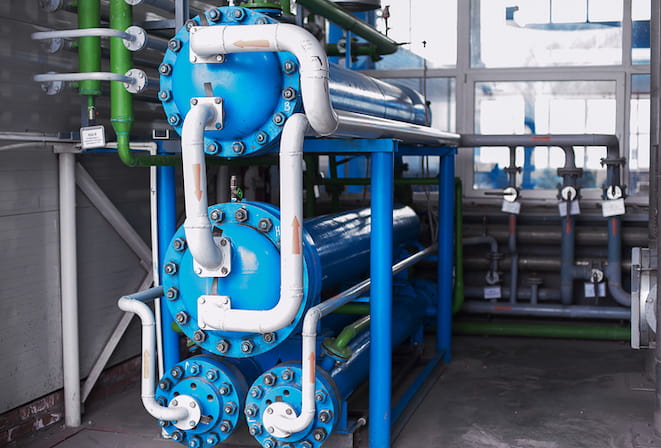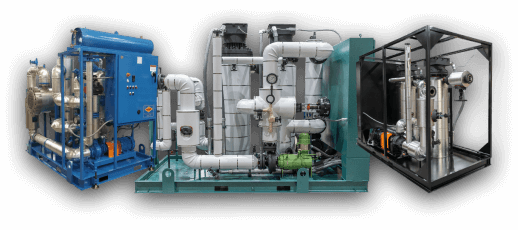A Comprehensive Guide to Choosing the Right Heat Transfer Systems for Your Demands
Picking the suitable Heat transfer system is crucial for functional efficiency. Different systems deal with different demands, affected by elements such as temperature array and liquid kind. Comprehending the concepts behind Heat transfer, such as radiation, convection, and transmission, is important. Additionally, assessing power resources and maintenance techniques can influence long-term performance. A closer examination of these factors to consider discloses just how to tailor a system to specific demands. What should one prioritize in this complex decision-making process?
Understanding Heat Transfer: Trick Ideas and Principles
Heat transfer might appear like a straightforward idea, it includes an array of concepts that are fundamental for reliable system design - DVS Heat Transfer Systems. Comprehending these concepts is crucial for designers and engineers who intend to enhance thermal efficiency in numerous applications. Conduction, for example, involves the transfer of Heat via solid materials, while convection describes the activity of Heat within liquids. Radiation, another vital principle, defines just how Heat can be transferred via electromagnetic waves. Each of these mechanisms plays a crucial role in identifying exactly how power moves within a system. By thoroughly grasping these principles, experts can make educated choices, making sure that Heat transfer systems operate effectively and meet the particular needs of their applications
Types of Heat Transfer Equipments: An Overview
Recognizing the principles of Heat transfer lays the groundwork for checking out the different kinds of Heat transfer systems offered. Heat transfer systems can be classified primarily into 3 kinds: conduction, radiation, and convection. Transmission entails Heat transfer via solid products, relying upon straight get in touch with in between fragments. Convection, on the other hand, happens in fluids (fluids and gases) where the motion of the fluid itself assists in Heat transfer. Radiation involves the transfer of Heat through electromagnetic waves and does not need a medium, enabling it to take place in a vacuum cleaner. Each sort of system has unique features and applications, making it essential for people and companies to meticulously examine their details requirements when picking one of the most suitable Heat transfer service.
Applications of Heat Transfer Systems in Various Industries
Heat transfer systems play a vital role throughout different sectors, influencing performance and product quality. In industrial manufacturing procedures, they assist in accurate temperature level control, while in food and drink handling, they guarantee safety and preservation. Furthermore, a/c and environment control systems count greatly on efficient Heat transfer to preserve comfy atmospheres.
Industrial Production Processes

Numerous commercial production processes count greatly on reliable Heat transfer systems to take full advantage of performance and improve item quality. In markets such as metalworking, Heat exchangers play an important function in preserving excellent temperatures during welding, spreading, and creating. These systems assure uniform Heat distribution, which is vital for achieving preferred material residential or commercial properties. In a similar way, in the chemical manufacturing market, Heat transfer systems assist in specific temperature level control throughout responses, impacting return and safety. Moreover, in textile manufacturing, reliable Heat monitoring is essential for coloring and completing processes, influencing shade uniformity and material quality. By selecting appropriate Heat transfer technologies, manufacturers can enhance energy performance and reduce functional expenses, inevitably causing a more affordable and sustainable production setting.
Food and Drink Processing
Effective Heat transfer systems are just as important in the food and beverage processing market, where preserving perfect temperature levels is vital for food safety and top quality. These systems play a vital function in processes such as cooking, sanitation, and pasteurization, ensuring that products are safe for consumption and maintain their nutritional worth. Heat exchangers, for circumstances, effectively move Heat between liquids, enhancing power use while lessening temperature variations. Additionally, refrigeration systems are essential for extending and maintaining perishable things service life. The option of Heat transfer technology directly impacts functional performance and product stability, making it vital for food and drink suppliers to pick the suitable systems customized to their particular handling demands. This careful choice eventually adds to customer satisfaction and food security.

Heating And Cooling and Climate Control
While several industries count on Heat transfer systems for effectiveness, A/C (Home Heating, Ventilation, and Air Conditioning) plays an essential duty in preserving indoor environment control throughout numerous settings. These systems utilize Heat transfer principles to control air, humidity, and temperature quality, ensuring comfort and safety and security in domestic, industrial, and industrial environments. Correctly developed heating and cooling systems boost energy effectiveness, reduce operational prices, and decrease ecological impact. In industrial buildings, for circumstances, effective climate control adds to staff member performance and consumer fulfillment. In commercial applications, heating and cooling systems assist keep excellent conditions for equipment operation and product preservation. Choosing the right Heat transfer system is essential for conference specific climate control needs and attaining general system efficiency.
Reviewing Energy Resources for Heat Transfer Solutions
In reviewing energy sources for Heat transfer systems, a contrast of renewable resource alternatives and nonrenewable fuel source factors to consider is crucial. Sustainable resources, such as solar and wind, offer sustainable choices that can minimize environmental influence. On the other hand, fossil fuels stay widespread due to their established facilities and power thickness, triggering a cautious assessment of both alternatives.
Renewable Energy Options

Nonrenewable Fuel Source Factors To Consider
Examining nonrenewable fuel source factors to consider is vital for the efficiency and sustainability of Heat transfer systems. Fossil fuels, such as gas, oil, and coal, are conventional power resources that offer substantial Heat outcome, making them preferred choices for commercial and residential applications. However, their ecological impact, including greenhouse gas discharges and resource deficiency, increases problems. When picking a warmth transfer system, it is crucial to assess the accessibility, cost, and governing factors related to these gas. In addition, the effectiveness of nonrenewable fuel source systems should be taken into consideration, as greater efficiency can minimize some environmental disadvantages. Eventually, a well balanced approach evaluating efficiency and sustainability can guide decision-makers toward the most proper Heat transfer remedy for their specific needs.
Elements to Think About When Picking a Warmth Transfer System
Choosing a suitable Heat transfer system needs careful consideration of different aspects that can substantially impact efficiency and performance. One important aspect is the operating temperature range, which dictates the products and style ideal for the application. his comment is here Additionally, the kind of fluid utilized in the system-- whether gas or fluid-- influences Heat transfer efficiency and compatibility. The system's dimension and capacity need to straighten with the specific requirements of the procedure to avoid ineffectiveness. Power resource schedule is additionally necessary, affecting operating expense and sustainability. Furthermore, the setup atmosphere, consisting of area restraints and accessibility for upkeep, plays a substantial role in system option. Ultimately, regulatory compliance and safety requirements must be taken into consideration to ensure the system meets all lawful needs.
Upkeep and Effectiveness Optimization for Heat Transfer Solutions
Maintaining Heat transfer systems is vital for ensuring optimal effectiveness and longevity. Routine upkeep tasks, such as cleansing Heat exchangers and checking insulation, aid prevent performance losses because of fouling and thermal linking. Additionally, checking system specifications, consisting of pressure and temperature level, permits very early discovery of abnormalities, reducing downtime and costly repair work. Applying a preventive my blog upkeep timetable can optimize performance and prolong the life-span of components. Furthermore, upgrading to innovative control systems can enhance operational performance by getting used to differing tons and conditions. By focusing on upkeep and performance optimization, operators can achieve lowered power usage, lower functional expenses, and enhanced total system integrity, ultimately leading to much better source usage and a more lasting procedure.
Future Patterns in Heat Transfer Technologies
As markets significantly prioritize sustainability and power effectiveness, future trends in Heat transfer technologies are set to undertake substantial makeovers. Technologies such as innovative materials, including carbon nanotubes and nanofluids, guarantee improved thermal conductivity and effectiveness. Additionally, the assimilation of renewable power resources into Heat transfer systems is obtaining energy, advertising eco-friendly remedies. Smart modern technologies, consisting of IoT sensing units, are anticipated to reinvent monitoring and control, enabling real-time information analysis for optimized efficiency. Additionally, the development of modular and portable systems will help with much easier setup and Recommended Site maintenance, accommodating diverse applications. These innovations indicate a shift in the direction of more sustainable, effective, and versatile Heat transfer solutions, straightening with worldwide power goals and environmental criteria.
Often Asked Inquiries
What Are the Ecological Impacts of Heat Transfer Equipments?
The environmental influences of Heat transfer systems can consist of greenhouse gas discharges, power intake, and potential thermal air pollution. Furthermore, inappropriate disposal of materials and ineffectiveness can add to resource deficiency and environment disturbance.
How Do I Determine the Cost-Effectiveness of a Warm Transfer System?
To determine the cost-effectiveness of a heat transfer system, one need to assess first costs, operational expenses, maintenance needs, and energy performance, comparing these aspects versus the expected life-span and performance of the system.
Can Heat Transfer Equipment Be Used in Residential Setups?
Heat transfer systems can without a doubt be utilized in residential setups. They provide reliable heating and cooling remedies, making homes a lot more comfortable while possibly lowering energy prices. Their versatility permits various applications in residential atmospheres.
What Safety Rules Apply to Heat Transfer Systems?
Security laws for Heat transfer systems typically include guidelines on upkeep, setup, and operation. Compliance with regional building ordinance, producer requirements, and market standards is necessary to ensure secure and efficient system efficiency in different applications.
Exactly How Do Various Materials Affect Heat Transfer Effectiveness?

Conduction, for circumstances, involves the transfer of Heat via strong materials, while convection refers to the activity of Heat within liquids. Recognizing the concepts of Heat transfer lays the groundwork for exploring the different kinds of Heat transfer systems readily available. Heat exchangers, for circumstances, successfully move Heat between fluids, optimizing energy usage while decreasing temperature changes. In examining power resources for Heat transfer systems, a contrast of renewable power options and fossil fuel factors to consider is important. Steels, such as copper and light weight aluminum, conduct Heat effectively, whereas insulators like rubber and glass slow down Heat flow.